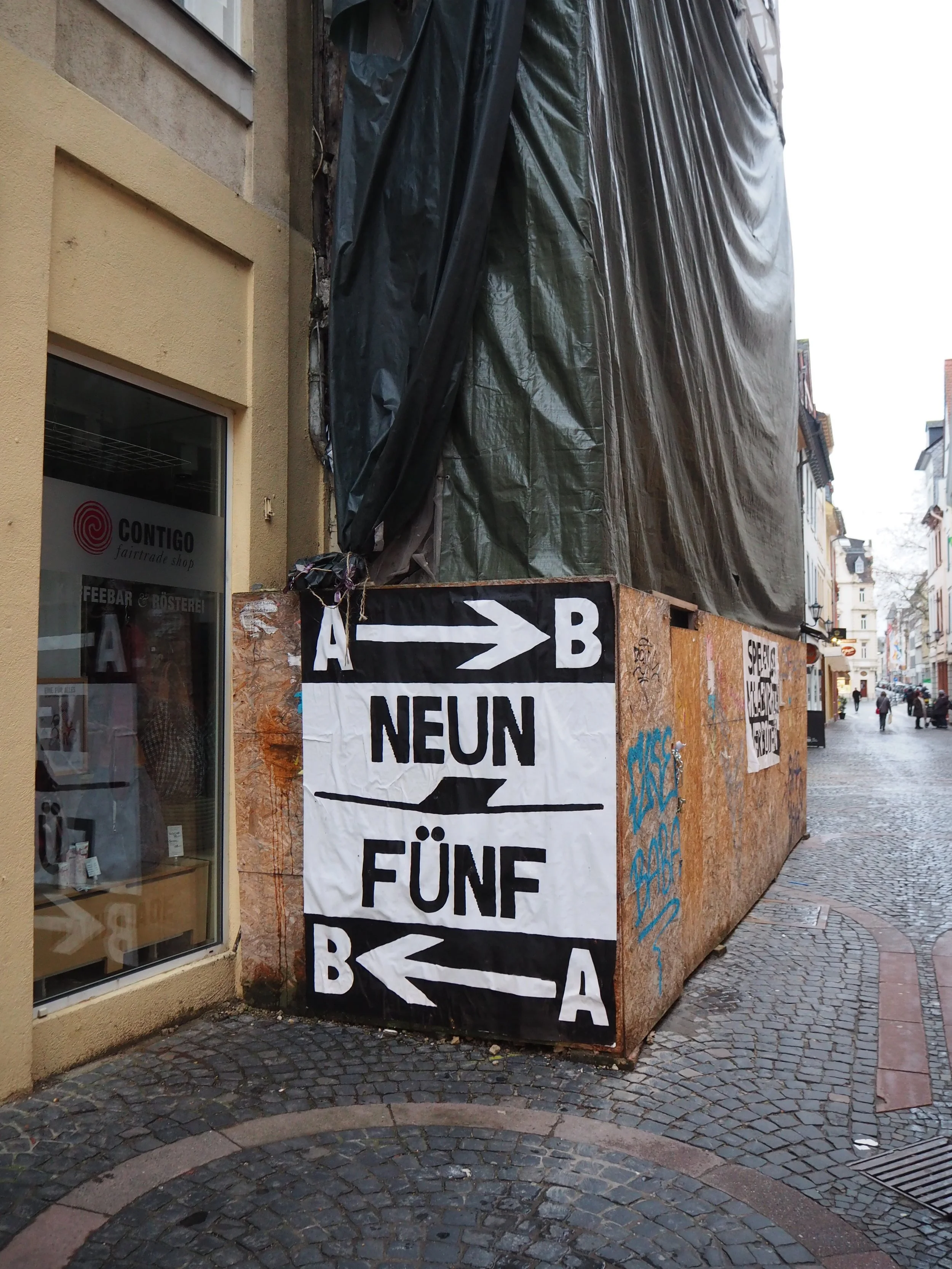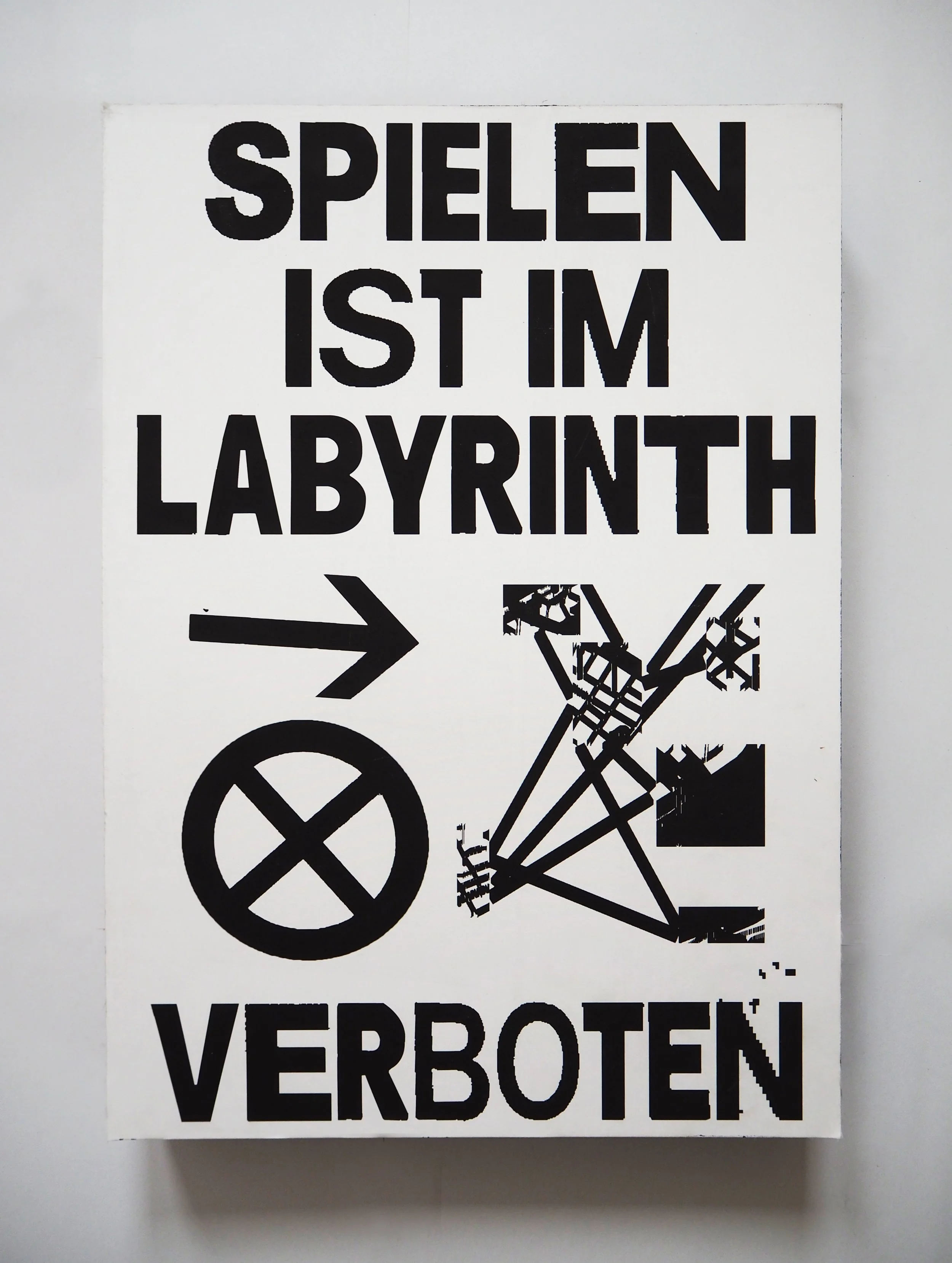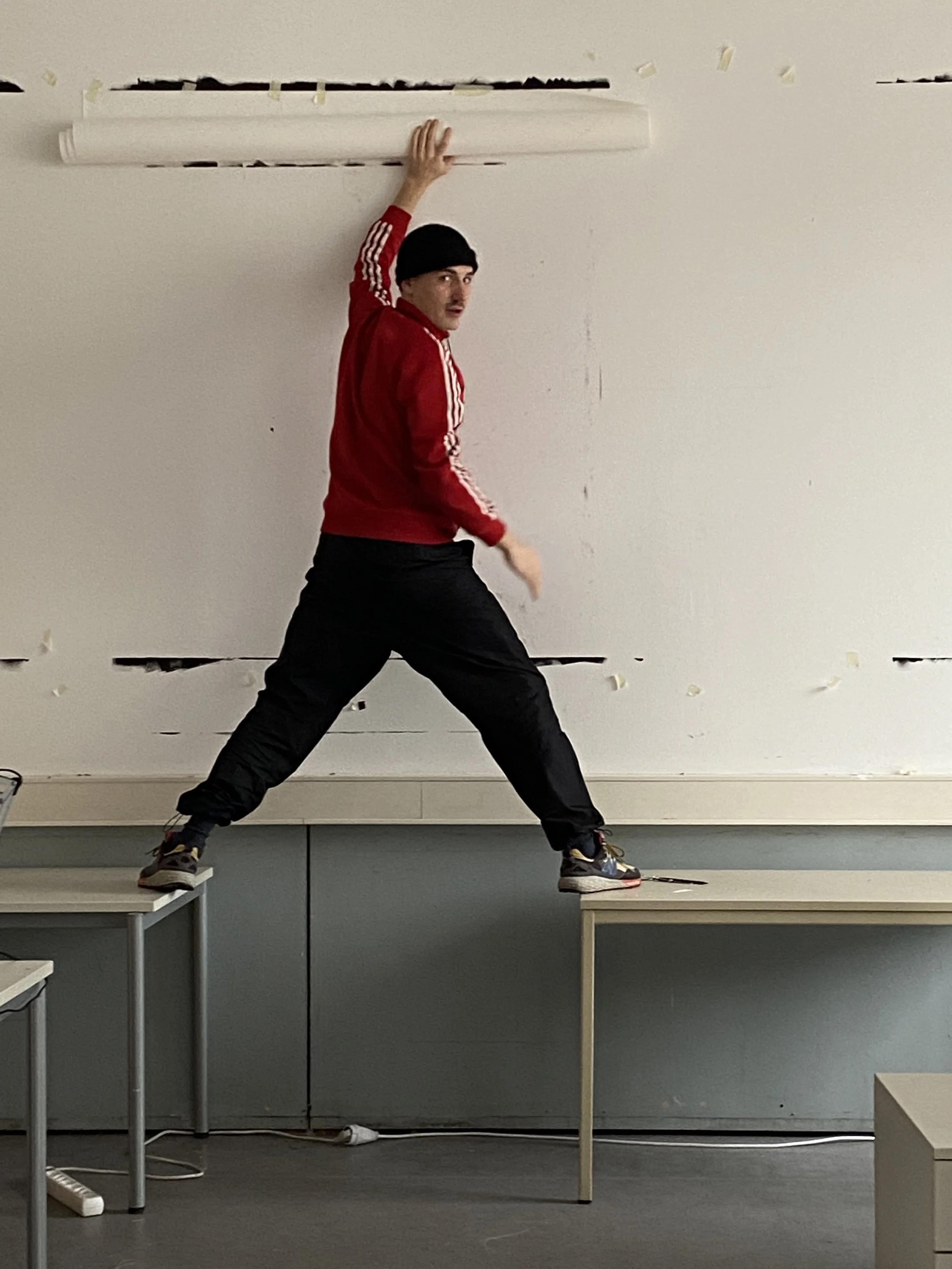Hannes Paefgen
Hannes, please introduce yourself:
Hello, I'm Hannes, 28 years old, graphic designer and I'm happy to talk to you about my master thesis, which I finished this spring at HS Mainz.
Sequence: »Spielen verboten«
#1 You completed your master's thesis in communication design at Mainz University of Applied Sciences earlier this year, which you also exhibited at the "It's a book" fair in Leipzig. In your work you dealt with the public space of the city. Tell us a bit more about it.
The origin of the work was that I felt like doing a fairly free project, the basis of which was graphic design, but could also go beyond that. With this, I mainly wanted to try to break away from common ways of working and thinking in graphic design. My ambition was to find a topic that gave me the possibility to work freely and to deal with a topic that is important to me. I wanted to work practically and design things that I might not be able to do in my professional life.
The public space thus served as a meaningful playing field for my practical work. The work resulted in large-format posters and banners, which I hung up in the city, as well as a large-format book documenting the work. At the "Its a book" fair in Leipzig I got the opportunity to exhibit a smaller reproduction of the book at a booth for student projects and to talk to people about it.
Book cover “Spielen ist im Labyrinth Verboten” (Playing is forbidden in the labyrinth)
#2 How did you get the idea to get so involved with public space as a graphic designer?
Public space has always been a thing that interests me, whether as a graphic designer or whatever. I would rather say I just deal with public space that way, regardless of a profession or the degree program I took. I would even say that everyone who lives in urban public space deals with it, whether consciously or unconsciously. This is probably one of the aspects that I find most interesting:
We talk a lot about participation, about political participation and about attitude. I think we can actually live all this out in public space as soon as we become aware that we are a part of this public space and not just move around in it indifferently. Society happens here, so why not start here?
This all sounds quite serious at first, but it is also - and here we come to one of the themes of my work - about playing.
You can (and should) protest, denounce and show attitude, but you should also play and acquire the space. And for me, playing in public space always means breaking with norms and practicing social critique at that moment, and that's how the circle closes again in a way.
#3 You drew inspiration from the works and theses of the Situationist International and the Atelier Populaire. How has this influenced your work?
The works, especially of the Situationists are the foundation of my theoretical work and therefore at the same time of my practical work. »The Situationist International« was a collective of activists and artists that was active in France and Europe, especially in the 1960s. Politically, the group has origins in leftist to communist parties and can be classified as anti-capitalist. This can be seen well in Guy Debord's "Society of the Spectacle" and in their reflections on public space, for example. Within the Situationists, a group emerged that was very much concerned with urbanism.
The various players published texts and artistic works in which they developed ideas on how man must reconceive public space. This is about understanding how the city works, how one lives in it oneself, about the relationship between the city and people, between society, politics and capital.
Many of these ideas are utopias, but they are also instructions on how to reconceive the city. I found the approaches and the ways of thinking very intriguing and at the same time still highly topical. Almost all of the topics addressed can be translated one-to-one into today's world. Therefore, I wanted to take up these very ideas for myself in my work, try to appropriate them and transfer them to my personal experience within the city in which I live.
#4 Can you briefly introduce us to the terms "derivé", "detournement", "psychogeography", and "unitary urbanism" and explain how these have informed your way of working?
Guy Debord, The Naked City, 1957
These are all terms from the Situationists' practice. They are the instructions or ways of thinking about how to reconceive urban space.
Derivé is the term used to describe wandering around, similar to Walter Benjamin's strolling. The "derivé" is a practice and an instruction to move in public space. The goal is to be guided by the city and to gather as many impressions as possible by aimlessly wandering around the city and to create attention for the space. In order to understand the city in which I move, I have used this very practice and have wandered around.
Detournement can be translated as misappropriation and, for the Situationists, it refers primarily to an artistic practice. In short, I take something, appropriate it, and put it into a new context. My entire graphic work is based on this idea. All the elements in my design are misappropriated. The typography works with different letters that I have extracted from the cityscape, just like all the graphic forms.
Psychogeography, like »derivé«, is primarily about understanding space. It is about how the city and processes in the city affect one, what effect they have and about experiences that can be drawn from them. Thus, psyschogeography is a very individual and personal practice in which one consciously exposes oneself to the city, so to speak. In the artistic practice, psyschogeographic maps are created to show which places one stays in, which neighborhoods one might skip, where one is drawn to, what is repulsive. Psyschogeography, like "derivé", was an important element for me in understanding the city for myself and being able to work with it.
Unitary urbanism basically represents the fusion of the different ideas and results in the utopia of a new urban space. In unitary urbanism, the experiences and insights are implemented artistically and practically. The Dutch situationist Constant, for example, develops a model of a utopian city with his project "New Babylon". Ideas of how this city functions and is constructed are derived from the various practices of the situationists. For Constant, this means an anti-capitalist city. Accessible to everyone and completely interconnected.
#5 What role does graphic design play for you in public space, or how do you see the role of the graphic designer in relation to public space?
To be honest, graphic design often plays a minor role in public spaces.
The graphics we see (especially in city centers) are commodity graphics that serve capitalist purposes alone. Advertising for all sorts of things. But we have already become so accustomed to it that in most cases it is no longer noticeable at all. It exists. But what does it do, does it do anything at all with us? I think everyone has to find that out for themselves.
At the same time, of course, there are a bunch of graphics in the public space. But they often don't come from graphic designers and many simply pass them by because they serve another purpose or are pure products of chance. (Which brings us back to the attention and ideas of the Situationists - and keeping in mind, of course, that not everyone and anyone wants to see everything, some may be disturbing or off-putting, which is ok).
Examples would be protest posters of political groups, art actions or graffiti. But also random situations such as broken lettering, construction sites, signs or the neighbor's note on your bike that you are not allowed to park it at this pole according to him.





#6 Where do you see challenges in the design of public space, also for architects and urban planners, now and in the future?
I think the biggest challenge is to take the inhabitants of a city along with you and not just build around them.
In the end, it's not the houses that make a city, but the people who live in them. The people who decide to design their house this way or that way, people who go out and actively participate.
Architects, urban planners, politicians and even graphic designers are, I think, not the panacea through their ideas (as we see in some current urban development projects). Their task must be to take the residents with them and to get them to rethink the city through their work. Currently, the opposite often happens and the actual residents are displaced and discouraged by architecture, urban planning and graphics. With exceptions that at least always please me very much, no matter how small they are.
#7 How do you see the role of the graphic designer in today's society?
Graphic design should not take itself so seriously in some moments and get down from the high horse it sits on here and there.
I do think that graphic design has the possibility to influence society, to show attitude and to convey political content. But you always have to be careful not to be instrumentalized and always question what purpose it actually serves. Trends and hypes also have to be questioned on a daily basis.
At the same time, graphic design is enormously important in today's society. In a way, it guides us all: in the city, on our cell phones, in the supermarket, everywhere. We have to be aware of that, we have to be able to deal with that. But there is no absolute answer to this in my eyes.
I at least don't think graphic designers are more important than other professions, maybe even rather the opposite.
#8 How does your environment influence your work?
I am someone who is very inspired by my surroundings. People, friends I surround myself with and conversations I have. I'm in the lucky situation to be able to say I have many interesting and creative people from different professions around me.
But I am also inspired by little things, funny coincidences that I meet on my ways through the city. In fact, regardless of the work we are talking about here, the city has always been a great inspiration. But I am also inspired in a certain way by critiques of social or aesthetic positions. It's a lot about what you want to reproduce and what you don't want to reproduce. What attracts or repels you.
These are all things that influence my practical work as a graphic designer. As you might be able to tell, I have a very ambiguous view of graphic design, and I think that's reflected in the practice and the way you deal with it.
#9 Three things that inspire you at the moment?
I just moved, so the new city I live in.
#10 What do you currently read, watch, listen to?
I just finished reading Eric Vuillard "An Honorable Exit" and started reading Noa Yedlin "People Like Us".
The Tour de France documentary just came out on Netflix, I like watching sports on TV so I started watching the first episode right away haha.
Since Astrud Gilberto passed away this week I listened to a lot of her music. Apart from that all kinds of music. A lot of hip hop and electronic music like jungle and footwork.
Links:
Instagram: @hhhhpaefgen, @_ps321
Photos: © Hannes Paefgen
Interview: Emily Paefgen




